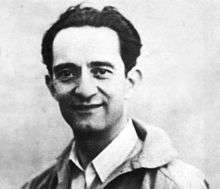Abolhassan Sadighi
| Master Abolhassan Khan Sadighi | |
|---|---|
 Master Abolhassan Khan Sadighi | |
| Born |
Abolhassan Khan Sadighi 1894 Tehran, Iran |
| Died |
11 December 1995 (aged 101) Tehran, Iran |
| Nationality | Iranian |
| Education | Master Kamal al-Molk Ghafarri |
| Known for | sculpture and painting |
| Notable work | Ferdowsi, Amir Kabir, Avicenna, Khayyam and Nader Shah statues |
Abolhassan Sadighi (Persian: ابوالحسن خان صدیقی) (1894 – December 11, 1995) was one of the most prominent Iranian sculptors and painters and was known as Master Sadighi.
Biography
He was born in Tehran in 1894.[1] He entered the Alliance school after finishing his primary education. There, he began painting and drawing without any teaching or guidance.[1]
His love for painting and drawing led him to become the student of Master Kamal-al-Molk Ghaffari.[2] He soon became one of the most remarkable art students of the master. At the end of his educational time in the School of Fine Arts (مدرسه صنایع مستظرفه) Master Kamal-al-Molk appointed him as an instructor of painting and drawing at the school.
Shortly after his employment he began to find himself attracted to sculpture. Without adequate means, he ventured to create his first stucco bust of a child and offered it to his master, Kamal-al-Molk. Abolhassan Khan Sadighi's innovative first sculpture was the beginning of a new movement in the art of sculpture in modern Iran.
After numerous experiences in creating plaster sculptures, he made his first stone sculpture on a stucco model of the Venus de Milo. The sculpture received so much attention and praise that Kamal-al-Molk took his apprentice and the Venus sculpture to the Imperial Court, and introduced him to Ahmad Shah of the Qajar dynasty. Then, after that meeting, Sadighi was offered a monthly salary from the order of Ahmad Shah and then became the director of the School of Delicate Crafts. Upon receiving this honor, he totally devoted himself to sculpture and made sculptures from both plaster and stone. These sculptures include the bust of Ferdowsi on the Eagle's Wings, the full statue of Amir Kabir, and the most memorable of all, Haji Moqbel the Black Flute Player.
In 1928 Kamal-al-Molk was exiled to Hosseinabad of Nishapur, which was deeply distressing to Sadighi; consequently, with a tiny amount of money that he had saved throughout the years, he left Iran for Europe. In Europe he visited many countries, and for four years he studied sculpture at the École des Beaux-Arts in France. His teacher was Ange Albert, the skillful master of sculpture at the École.
In Beaux-Arts he managed to prove himself more talented in competition with other art students at the École. During his stay in Europe, he created, in addition to sculptures, some works in oil and watercolour which showed the influence he received from the new European art movements of the time.
In 1932, after returning to Iran, he accepted a request from his the exiled Kamal-al-Molk to re-open the School of Delicate Crafts and be its director. Once again, the school became a center of visual art, which played a major role in the development of sculpture in modern Iran.
The School of Delicate Crafts lasted almost to the death of Master Kamal-al-Molk, and then was closed. Sometime later the school rematerialised in another form of art school, under the new name, the Institute of Fine Arts (هنرستان هنرهای زیبا), under the patronage of the Ministry of Art and Culture, in which Sadighi taught sculpture.
A few years after the school was established, it became a part of Tehran University. It then became known as the Faculty of Fine Arts and had various art branches, including a department for sculpture under the supervision of Sadighi until he retired from Tehran University in 1967.
In addition to teaching sculpture to numerous art students and creating many oil and watercolour paintings, Sadighi made the huge and monumental stone statue of Justice, which was 2.70 meters high and which was commissioned by the Tehran courthouse.
In 1950, Master Sadighi accepted a membership in the National Art Works Society and entered the most creative period of his life. He made many enduring statues of celebrated Iranian men of literature and science such as Sheikh Sa'di of Shiraz, Ferdowsi of Tus, the great philosopher and physician Abu Ali Sina (Avicenna), and the bronze statue of Nader Shah Accompanied by His Horseman, which was cast in Milan, Italy. The most important of his works during that period was the statue of Ferdowsi, which was set up in the Villa Borghese Square in Rome and made the sculptor well known to European art societies.
Sadighi's last works as a sculptor were busts and statues of the Iranian poet and philosopher Omar Khayyam. He then isolated himself from the art world almost entirely, and spent time raising his family.
Abolhassan Khan Sadighi died in 1995.
References
- 1 2 "The master, Paintings & sculptures of Abolhassan Khan Sadighi". Iranian.com. Retrieved March 2, 2007.
- ↑ Seyf, Hadi. "Master Abolhassan Khan Sadighi; The Michelangelo of the East". Archived from the original on May 13, 2012. Retrieved March 2, 2007.
External links
| Wikimedia Commons has media related to Abolhassan Sediqi. |
- "The Life and Arts of Master Abolhassan Khan Sadighi". Archived from the original on May 13, 2012.
- "The master, Paintings & sculptures of Abolhassan Khan Sadighi". Iranian.com. Retrieved March 2, 2007.